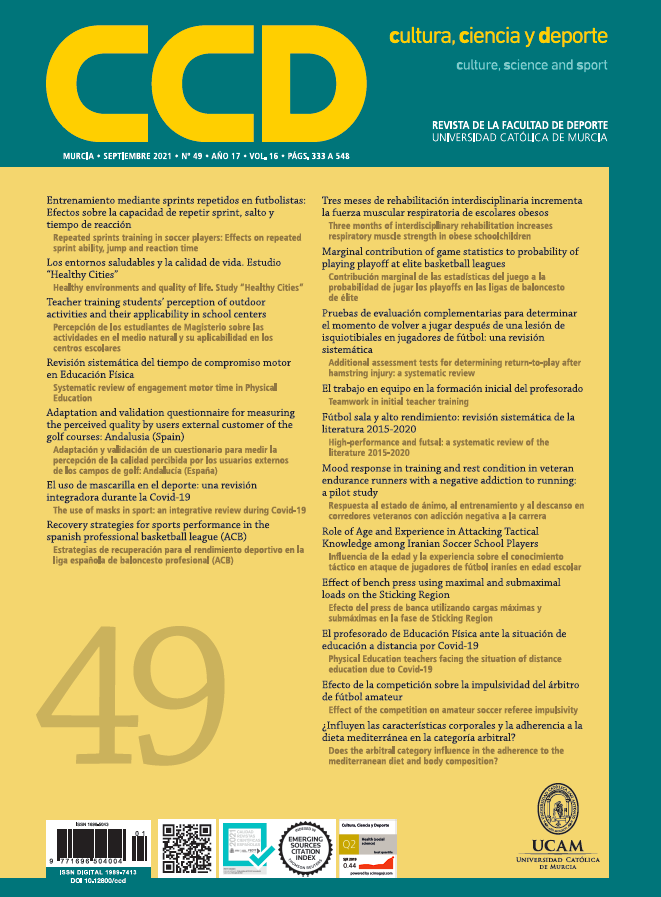Efecto del press de banca utilizando cargas máximas y submáximas en la fase de Sticking Region
DOI:
https://doi.org/10.12800/ccd.v16i49.1605Keywords:
Braking phase, Chest Press, Triceps brachii, Electromyography.Abstract
El objeto de este estudio fue analizar la Sticking Region en las cargas submáximas (70%, 80%, 90% hasta el fallo) y máximas (1RM) durante la fase concéntrica en press de banca. Para este estudio, fueron once los participantes (edad: 22,73 ± 2,57 años; masa corporal: 80,2 ± 6,9 kg; altura: 179,6 ± 7,4 cm; 1RM: 94,55 ± 11,56 kg) con al menos dos años de experiencia en press de banca. En nuestra muestra, la Sticking Region solo pudo ser observada en las cargas del 90% y 100% 1RM. Los resultados de velocidad mostraron diferencias estadísticamente significativas en 1RM (p ≤ 0,001) y en 90% (p = 0,014) durante las tres fases (Pre-Sticking, Sticking Region y Post-Sticking). Observamos diferencias en la actividad electromiográfica del tríceps entre las regiones Pre-Sticking y Sticking, así como entre la region Pre-Sticking y Post-Sticking en la carga de 1RM. La actividad entre la Sticking Region y Post-Sticking Region, en las cargas del 90% y 100% no mostró diferencias estadísticamente significativas. Este estudio sugiere que la Sticking Region es más visible en cargas máximas (1RM) debido a una baja posición mecánica.
References
Barnett, C., Kippers, V., Van den Tillaar, R., & Saeterbakken, A. (2014). Effect of Fatigue Upon Performance and Electromyographic Activity in 6-RM Bench Press. Journal of Human Kinetics, 40(1), 57-65. doi:10.2478/hukin-2014-0007
Borba, D. D. A., Batista Ferreira-Júnior, J., Ramos, M. V. D., Gomes, R. D. L. D., Guimarães, J. B., & Oliveira, J. R. V. D. (2018). Bench press exercise performed as conditioning activity improves shot put performance in untrained subjects. Motriz: Revista de Educação Física, 24(4). doi:10.1590/s1980-6574201800040003
Brzycki, M. (1993). Strength testing-predicting a one-rep max from reps-to-fatigue. Journal of Physical Education, Recreation and Dance, 64(1), 88-90. doi: 10.1080/07303084.1993.10606684
Cram, J., Kasman, G., & Holtz, J. (1998). Electrode placements. Introduction to surface electromyography. Aspen.
Delagi, E. F., Perotto, A., Lazzetti, J., & Morrison, D. (1981). Anatomic Guide for the Eletromyographer: the limbs. (2nd edition). Charles C Thomas Publisher.
Drinkwater, E. J., Lawton, T. W., Lindsell, R. P., Pyne, D. B., Hunt, P. H., & Mckenna, M. J. (2005). Training leading to repetition failure enhances bench press strength gains in elite junior athletes. The Journal of Strength & Conditioning Research, 19(2), 382-388.
Elliott, B.C., Wilson, G.J., & Kerr, G.K. (1989). A biomechanical analysis of the sticking region in the bench press. Medicine and science in sports and exercise, 21(4), 450-462.
Frost, D.M., Cronin, J., & Newton, R.U. (2010). A biomechanical evaluation of resistance. Sports Medicine, 40(4), 303-326. doi:0112-1642/10/0004-0303/$49.95/0
García-Manso, J.M. & Valverde-Esteve, T. (2015). Potencia muscular y rendimiento deportivo. Kinesis.
Gomo, O., & Van Den Tillaar, R. (2016). The effects of grip width on sticking region in bench press. Journal of sports sciences, 34(3), 232-238. doi: 10.1080/02640414.2015.1046395
Lander, J.E., Bates, B.T., Sawhill, J.A., & Hamill, J. (1985). A comparison between free-weight and isokinetic bench pressing. Medicine and science in sports and exercise, 17(3), 344-353.
Madsen, N., & McLaughlin, T. (1984). Kinematic factors influencing performance and injury risk in the bench press exercise. Medicine and science in sports and exercise, 16(4), 376-381.
Marques, M. C., Van Den Tillaar, R., Vescovi, J. D., & González-Badillo, J. J. (2007). Relationship between throwing velocity, muscle power, and bar velocity during bench press in elite handball players. International journal of sports physiology and performance, 2(4), 414-422.
McLaughlin, T.M., & Madsen, N.H. (1984). Bench Press: Bench press techniques of elite heavyweight powerlifters. Strength and Conditioning Journal, 6(4), 44-44.
Newton, R.U., Kraemer, W.J., Haekkinen, K., Humphries, B., & Murphy, A.J. (1996). Kinematics, kinetics, and muscle activation during explosive upper body movements. Journal of Applied Biomechanics, 12(1), 31-43.
Newton, R.U., Murphy, A.J., Humphries, B.J., Wilson, G.J., Kraemer, W.J., & Häkkinen, K. (1997). Influence of load and stretch shortening cycle on the kinematics, kinetics and muscle activation that occurs during explosive upper-body movements. European journal of applied physiology and occupational physiology, 75(4), 333-342.
Saeterbakken, A.H., Van den Tillaar, R., & Fimland, M.S. (2011). A comparison of muscle activity and 1-RM strength of three chest-press exercises with different stability requirements. Journal of sports sciences, 29(5), 533-538. doi: 10.1080/02640414.2010.543916
Stastny, P., Gołaś, A., Blazek, D., Maszczyk, A., Wilk, M., Pietraszewski, P., ... & Zając, A. (2017). A systematic review of surface electromyography analyses of the bench press movement task. PloS one, 12(2), e0171632. doi: 0.1371/journal.pone.0171632
Van den Tillaar, R., Andersen, V., & Saeterbakken, A. H. (2014). The existence of a sticking region in free weight squats. Journal of human kinetics, 42(1), 63-71. doi: 10.2478/hukin-2014-0061
Van Den Tillaar, & Ettema (2009). A comparison of successful and unsuccessful attempts in maximal bench pressing. Medicine and science in sports and exercise, 41(11), 2056-2063. doi: 10.1249/MSS.0b013e3181a8c360
Van den Tillaar, R., & Ettema, G. (2010). The “sticking period” in a maximum bench press. Journal of sports sciences, 28(5), 529-535. doi: DOI:10.1080/02640411003628022
Van den Tillaar, R., & Ettema, G. (2013). A comparison of muscle activity in concentric and counter movement maximum bench press. Journal of human kinetics, 38, 63-71. doi: 10.2478/hukin-2013-0046
Van den Tillaar, R., & Kwan, K. (2020). The Effects of Augmented Eccentric Loading upon Kinematics and Muscle Activation in Bench Press Performance. Journal of Functional Morphology Kinesioly,5(1), 1-12.
Van den Tillaar, R., Saeterbakken, A., & Ettema, G. (2012). A comparison of muscle activation between maximum pure concentric and counter movement bench pressing. In ISBS-Conference Proceedings Archive, 1 (1).
Van Den Tillaar, R., & Saeterbakken, A. H. (2013). Fatigue effects upon sticking region and electromyography in a six-repetition maximum bench press. Journal of sports sciences, 31(16), 1823-1830. Doi: 10.1080/02640414.2013.803593
Van den Tillaar, R., Saeterbakken, A.H., & Ettema, G. (2012). Is the occurrence of the sticking region the result of diminishing potentiation in bench press? Journal of Sports Sciences, 30(6), 591-599. Doi: 10.1080/02640414.2012.658844
Wagner, L.L., Evans, S.A., Weir, J.P., Housh, T.J., & Johnson, G.O. (1992). The effect of grip width on bench press performance. Journal of Applied Biomechanics, 8(1), 1-10.
Downloads
Published
How to Cite
Issue
Section
License
Copyright (c) 2021 Creative Commons Attribution License

This work is licensed under a Creative Commons Attribution-NonCommercial-ShareAlike 4.0 International License.
The authors who publish in this journal agree with the following terms:
- The authors retain the copyright and guarantee the journal the right to be the first publication of the work as well as licensed under a Creative Commons Attribution License that allows others to share the work with recognition of the authorship of the work and the initial publication in this journal.
















